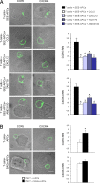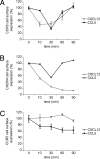CXCR4-CCR5: a couple modulating T cell functions
- PMID: 18632580
- PMCID: PMC2481367
- DOI: 10.1073/pnas.0804286105
CXCR4-CCR5: a couple modulating T cell functions
Abstract
Chemokines and their receptors direct leukocyte migration among blood, lymph and tissues. Evidence has recently accumulated that, besides their chemotactic functions, chemokine receptors are highly versatile players that fine tune immune responses. During human T cell activation by antigen-presenting cells, the chemokine receptors CCR5 and CXCR4 are recruited into the immunological synapse, where they deliver costimulatory signals. However, the molecular mechanisms allowing signaling versatility of chemokine receptors are unknown. Here, we describe the functional interaction between CXCR4 and CCR5 to exert specific biological functions and modulate T lymphocyte responses. We demonstrate that simultaneous expression and cooperation between CCR5 and CXCR4 are required for chemokine-induced T cell costimulation at the immunological synapse. In addition, we provide evidence for a physical association of the two receptors in a signaling complex that activates distinct T cell functions. We suggest that cooperation between receptors represents one key strategy for the functional plasticity of chemokines.
Conflict of interest statement
The authors declare no conflict of interest.
Figures





References
-
- Lanzavecchia A, Lezzi G, Viola A. From TCR engagement to T cell activation: A kinetic view of T cell behavior. Cell. 1999;96:1–4. - PubMed
-
- Gerard C, Rollins BJ. Chemokines and disease. Nat Immunol. 2001;2:108–115. - PubMed
-
- Viola A, Luster AD. Chemokines and Their Receptors: Drug Targets in Immunity and Inflammation. Annu Rev Pharmacol Toxicol. 2008;48:171–197. - PubMed
-
- Viola A, Contento RL, Molon B. T cells and their partners: The chemokine dating agency. Trends Immunol. 2006;27:421–427. - PubMed
-
- Molon B, Gri G, Bettella M, Gomez-Mouton C, Lanzavecchia A, et al. T cell costimulation by chemokine receptors. Nat Immunol. 2005;6:465–471. - PubMed
Publication types
MeSH terms
Substances
Grants and funding
LinkOut - more resources
Full Text Sources
Other Literature Sources
Molecular Biology Databases

